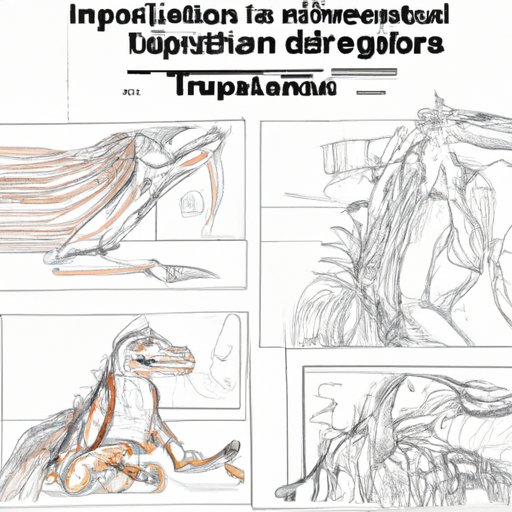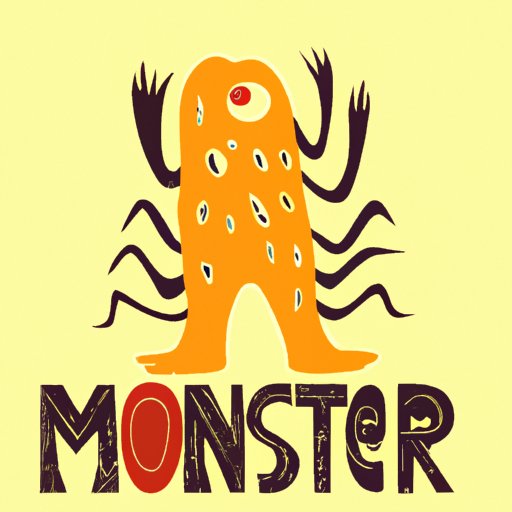I. Introduction
Monsters are a staple of pop culture, from horror movies to children’s books. Whether you’re a seasoned artist or just starting out, drawing monsters can be a fun and rewarding exercise in creativity. In this article, we’ll cover everything you need to know to draw your own monsters, from simple shapes and beginner techniques to more advanced tips for creating truly terrifying creatures. So, grab a sketchbook and let’s get started!
II. 5 Simple Steps to Draw a Monster: A Beginner’s Guide
The first step in drawing a monster is to create a basic shape. Start with a circle, oval, or other simple shape for the body, and add triangles or rectangles for the limbs. Once you have a basic shape, you can start adding details like eyes, teeth, and claws to give your monster personality and character. Experiment with different shapes and styles to create a variety of monsters, from cute and cuddly to downright scary.
Tip: Don’t be afraid to mix and match different features from animals or other creatures to create a truly unique monster.
Examples:
- Cyclops monster with one eye and large, muscular arms and legs
- Goblin monster with pointed ears, sharp teeth, and a mischievous grin
- Dragon monster with wings, horns, and fiery breath
III. The Art of Creating a Fearsome Monster: Tips and Techniques
For those looking to create more complex and scary monsters, there are a number of advanced techniques to try. One of the key elements of creating a fearsome monster is using contrast and lighting to create depth and shadows. Choose colors and shading techniques that will make your monster stand out, whether it’s a shadowy fiend or a brightly-colored beast. Consider adding textures to your monster, such as scales or fur, and think about how different materials would interact with light.
Examples:
- Ghoul monster with rotting skin, glowing eyes, and tattered clothing
- Frankenstein monster with bolts in its neck, stitches on its skin, and a lumbering gait
- Alien monster with multiple limbs, a slimy texture, and glowing green blood
IV. From Imagination to Paper: How to Bring Your Monster Designs to Life
The process of creating a monster starts in the mind, and there are a number of strategies you can use to generate ideas for your designs. Try brainstorming different combinations of monster features, or sketching out rough drafts of different types of monsters. Once you have an idea in mind, transfer it onto paper using rough sketches or detailed drawings. Use a variety of materials to bring your monster to life, such as pencil, ink, or digital tools. Don’t be afraid to make changes and adjustments until your monster looks just right.
Tip: If you’re having trouble visualizing your monster, try looking at reference photos or sketches of animals or other creatures to get ideas.
V. Drawing Monsters for Kids: A Fun Art Activity Guide
Drawing monsters can be a great activity for kids, whether they’re just starting out or looking to expand their skills. Start by making simple monsters with basic shapes and features, and encourage kids to experiment with colors, patterns, and other design elements. You can also create games and challenges that involve drawing monsters, such as a game where each player takes turns adding a feature to a shared monster drawing. With a little imagination, the possibilities are endless.
Examples:
- Furry monster with googly eyes and a big smile
- Pirate monster with a patch over one eye and a peg leg
- Superhero monster with a cape and a lightning bolt on its chest
VI. How to Add Texture and Depth to Your Monster Drawings
Adding texture to a monster is a great way to give it a more realistic and dynamic look. Think about the surfaces of your monster, such as its skin, fur, or scales, and consider how the textures of various materials would look under different lighting conditions. Use shading and highlights to create a sense of depth and volume in your drawings, and experiment with different materials and techniques to create unique effects.
Examples:
- Furry monster with detailed hair shading and individual strands
- Scaled monster with shiny, reflective scales and a light source to create shadows
- Zombie monster with rotten skin, exposed bones, and dripping blood
VII. Exploring Different Monster Archetypes and How to Draw Them
There are countless different types of monsters out there, each with their own unique features and characteristics. Some of the most common monster archetypes include vampires, zombies, werewolves, and mummies. To draw these types of monsters, start by studying their defining features, such as fangs or claws, and experiment with different design elements to make them your own. You can also create entirely new types of monsters by combining different archetypes or adding your own personal touches.
Examples:
- Vampire monster with sharp teeth, pale skin, and a cape
- Zombie monster with rotting flesh, sunken eyes, and a limp
- Werewolf monster with fur, fangs, and a menacing growl

VIII. Finding Inspiration for Your Creature Drawings: Tips from Professional Artists
For those looking to take their monster drawing skills to the next level, there’s nothing like learning from the pros. Professional artists who specialize in creature design have a wealth of experience and knowledge to share, from where to find inspiration to how to refine and perfect your designs. Look for interviews and quotes from artists online or in art books, and study their artwork to learn new techniques and ideas.
Example:
- Interview with Stan Winston, Academy Award-winning creature designer for films such as Jurassic Park and Terminator 2
IX. Conclusion
Drawing monsters is a fun and rewarding way to exercise your creativity and imagination. Whether you’re a beginner or an experienced artist, there’s always something new to learn and discover when it comes to monster design. With the tips and techniques covered in this article, you’ll be well on your way to creating some truly terrifying creatures that are sure to impress.
